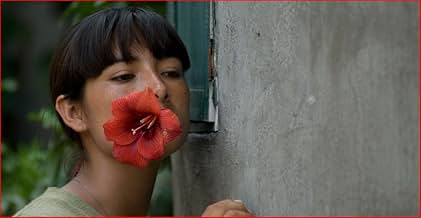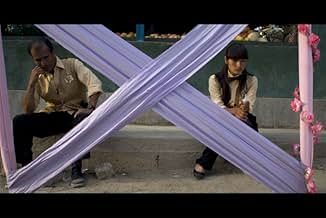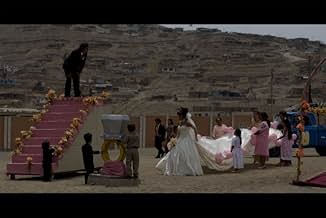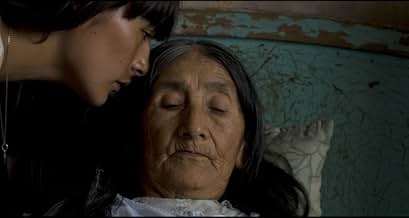VALUTAZIONE IMDb
6,7/10
7548
LA TUA VALUTAZIONE
Fausta soffre di una rara malattia chiamata "Milk of Sorrow", che viene trasmessa attraverso il latte materno delle donne che sono state maltrattate durante o subito dopo la gravidanza.Fausta soffre di una rara malattia chiamata "Milk of Sorrow", che viene trasmessa attraverso il latte materno delle donne che sono state maltrattate durante o subito dopo la gravidanza.Fausta soffre di una rara malattia chiamata "Milk of Sorrow", che viene trasmessa attraverso il latte materno delle donne che sono state maltrattate durante o subito dopo la gravidanza.
- Regia
- Sceneggiatura
- Star
- Candidato a 1 Oscar
- 16 vittorie e 6 candidature totali
Recensioni in evidenza
I was so touched by this film, which is obviously a low budget production. It proves that you do not need a multi-billion budget to make a good movie. I think only women can understand fully the pain and the fear the heroine had to go through. I wonder if they produce a sound track for the movie. The songs by the heroine and that sonata adopted by the pianist were beautiful. Solier is a great actress and her facial features, well, what can I say, is not the kind of glamour you find on screens. She has character, reflecting her heritage. I immediately take a liking of her from the first few scenes.I It is disturbing to find people snubbing such a beautiful movie but I guess everyone to his/her tase.
Our heroine is called Fausta, a girl who is full of fear. "The Milk of Sorrow" or, more exactly "The Frightened Tit" is, in the Peruvian-indigenous tradition, an illness, is being condemned to be a coward. Peru's late History was influenced by guerrilla's warfare and state brutality. Women (like Fausta's mother) were raped, and raped women got sick... of fear. through her mother's milk Fausta is afraid of life, but she is by no mean a coward, because after her mother dies, her struggle is by herself. This movie is beautiful, it combines a very, very strong performance from Magaly Solier, and a universal human struggle in a very typical Latin American city.
Winner of the first award at the Berlinale, La teta asustada is the second film made by Claudia Llosa, director of the brilliant and exotic Madeinusa. The movie shows an interesting picture of a village in Peru, the life of a family, the things they do to earn a living, and the fears of Fausta, a girl whose mother taught her the power of songs to send away tears.Fausta keeps a secret, and she wants no one to discover it. Meanwhile, he tries to save money to make a wish come true.Magaly Solier plays a gorgeous role, like she did in Madeinusa, and makes us share her feelings through her eyes and her voice. Besides, the film shows the customs of a family and the way every member helps doing his best with a smile. Don't miss it.
Writer/director Claudia Llosa loosely adapts the premise of old-time classics 'The Little Mermaid' and 'Faust' to contemporary Peru. Fausta, beautifully played by Magaly Solier, is a solitary, indigenous girl whose heart is gripped by fear. Her mother, who we see on her deathbed at the start of the film, was raped and scarred for life by The Shining Path (a radical Maoist organization that terrorized Peru during the 80s and early 90s). According to their indigenous culture, the terror felt by Fausta's mother was passed on to her through breastfeeding, a condition they call 'The Milk of Sorrow' (in Spanish, 'La Teta Asustada', which translates to 'The Frightened Tit'). Fausta is deeply suspicious of people around her, particularly men, and expresses her repressed emotions only through singing, as she performs her daily chores. Desperately in need for money to bury her dead mother, she begins to work as a housekeeper for Aida, a musician who is preparing for a concert and becomes interested in her songs of sorrow.
Llosa observes the social realities of Latin America (post-colonialism, class division, political violence), but avoids providing facile solutions. Instead, she focuses her attention on Fausta's more personal need for spiritual freedom. She does so with quiet, subtle humor and an eye for striking, poetic imagery.
I highly recommend watching this Academy Award nominee for Best Foreign Language Film and winner of the Berlin International Film Festival.
Llosa observes the social realities of Latin America (post-colonialism, class division, political violence), but avoids providing facile solutions. Instead, she focuses her attention on Fausta's more personal need for spiritual freedom. She does so with quiet, subtle humor and an eye for striking, poetic imagery.
I highly recommend watching this Academy Award nominee for Best Foreign Language Film and winner of the Berlin International Film Festival.
A realistic portrayal of the impoverished suburbia of Lima, Peru is the frame-set for this fantastic story. Fausta, daughter of a woman raped by terrorists some 25 years ago, assists her mother's death and decides to take her remains back to her hometown, in the high Andes. But, apart from having to work hard to collect the money she needs for it, Fausta has a reason, deep inside, that prevents her from enjoying life or accepting her outstanding physical beauty as a normal girl.
Mastery at low-budget cinematic skill should be credited to Bollywood (the Mumbai-based Hindi language film industry) films, which may not be the most groundbreaking in technical or screen writing terms, but contain music in the form of song-and-dance numbers woven into the script in order to appeal to all segments of the audience and maximise box office receipts. Since Hollywood's multi-million budgets would never have helped shoot realistic and colourful, but rough Brazilian imagery, 'Central Station' (1998) and 'Cidade de Deus' (2002) garnered indisputable acclaim at renowned film festivals after being funded on their own. The example set by off-Hollywood movie makers' efforts have become heroic in countries where movie industry budgets are, to say the least, scarce.
This is the case for LTA. It could have been more on par to Danny Boyle's 'Slumdog Millionaire' if it wasn't for the Peruvian-Spanish meagre budget available to Peruvian young director Claudia Llosa. If you expect to see acting beaus or beautés, famous screenwriters and crew, expensive car explosions or CGI, go elsewhere. LTA is neat magic-realism, a territory where people may be poor but not disgusting, where their houses are mere recreation centres for fantasy and everyday life to play happily together. Only time will tell if the trend keeps up, spreads globally, and ends up being called Globbywood.
This is a well-told tale of hope where only two professional actors are involved. And this was as clear to Berlinale judges as it is for the general public -those with a thirst for veritable, honest, witty craftsmanship at film-making.
Mastery at low-budget cinematic skill should be credited to Bollywood (the Mumbai-based Hindi language film industry) films, which may not be the most groundbreaking in technical or screen writing terms, but contain music in the form of song-and-dance numbers woven into the script in order to appeal to all segments of the audience and maximise box office receipts. Since Hollywood's multi-million budgets would never have helped shoot realistic and colourful, but rough Brazilian imagery, 'Central Station' (1998) and 'Cidade de Deus' (2002) garnered indisputable acclaim at renowned film festivals after being funded on their own. The example set by off-Hollywood movie makers' efforts have become heroic in countries where movie industry budgets are, to say the least, scarce.
This is the case for LTA. It could have been more on par to Danny Boyle's 'Slumdog Millionaire' if it wasn't for the Peruvian-Spanish meagre budget available to Peruvian young director Claudia Llosa. If you expect to see acting beaus or beautés, famous screenwriters and crew, expensive car explosions or CGI, go elsewhere. LTA is neat magic-realism, a territory where people may be poor but not disgusting, where their houses are mere recreation centres for fantasy and everyday life to play happily together. Only time will tell if the trend keeps up, spreads globally, and ends up being called Globbywood.
This is a well-told tale of hope where only two professional actors are involved. And this was as clear to Berlinale judges as it is for the general public -those with a thirst for veritable, honest, witty craftsmanship at film-making.
Lo sapevi?
- QuizMagaly Solier used to sell Puca picante (Andean treat) in the street before she was discovered by Claudia Llosa in 2005 while looking for extras for Madeinusa (her first film). Now she's a recognized actress and talented singer.
- ConnessioniFeatured in Brief Film Reviews: The Milk of Sorrow (2010)
- Colonne sonoreQuizás algún día
Music by Magaly Solier
Lyrics by Claudia Llosa
Performed by Magaly Solier and Bárbara Lazón
I più visti
Accedi per valutare e creare un elenco di titoli salvati per ottenere consigli personalizzati
- How long is The Milk of Sorrow?Powered by Alexa
Dettagli
Botteghino
- Lordo Stati Uniti e Canada
- 10.462 USD
- Fine settimana di apertura Stati Uniti e Canada
- 1914 USD
- 29 ago 2010
- Lordo in tutto il mondo
- 1.557.750 USD
- Tempo di esecuzione1 ora 35 minuti
- Colore
- Mix di suoni
- Proporzioni
- 1.85 : 1
Contribuisci a questa pagina
Suggerisci una modifica o aggiungi i contenuti mancanti























